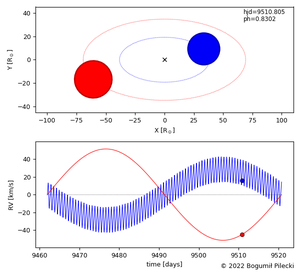
Classical Cepheids are important objects for various fields of astronomy like stellar oscillations and evolution of intermediate and massive stars, and with enormous influence on modern cosmology, being one of the best distance indicators in the universe. However, our understanding of these stars has still many flaws, and new observations bring interesting surprises.
In an article "Discovery of a binary-origin classical Cepheid in a binary system with a 59-day orbital period" recently published in the renowned journal, the Astrophysical Journal Letters, Bogumił Pilecki from the Nicolaus Copernicus Astronomical Center in Warsaw, together with his collaborators from Poland, the United States, Italy and Chile, described a discovery of a binary system OGLE-LMC-CEP-1347, a classical Cepheid and an accompanying giant star, with a surprisingly short orbital period (59 days) and a puzzling mass ratio of the components - the Cepheid being almost two times more massive than its companion.
Why is that important? Similar systems with Cepheids have orbital periods of one to several years with the shortest one measured before of 310 days. The new measurement thus broke the record already by more than five times. Moreover, previously done simulations showed that orbital periods shorter than 200 days should be extremely rare, so finding something so deep below this limit was totally unexpected. The only explanation for such a configuration is that the Cepheid has not yet passed through the red giant branch (being currently in the Hertzsprung gap), as otherwise it would interact with its companion, creating a system of completely different properties.
Observational data also indicate that the Cepheid and its companion are both evolved stars in a similar evolutionary state and thus should have similar masses, but that is not the case. The measured mass ratio of 0.55 clearly contradicts the stellar evolution theory. The most viable explanation for that mystery is that in the beginning, the system was composed of three stars, and at some point, two of them merged and created the current Cepheid. Interestingly, this binary-origin Cepheid will expand so much along its future evolution that, because of the relatively low separation of the components, it may likely pass through another binary interaction.
This discovery sheds light on one of the possible origins of Cepheids as mergers, which is not being considered in current studies, and on the complex interactions in similar systems of multiple stars. The presented Cepheid is also the first double-mode one found in a system of two giants. The study of double-mode Cepheids in such systems may serve to create a tool to easily measure masses of other stars of this type, even single ones. It is also the shortest-period Cepheid ever found in a binary system, which means we can extend our knowledge toward the lowest-mass Cepheids (shorter-period ones have lower masses). Such low-mass, short-period Cepheids currently lack empirical description, and there are theoretical obstacles in explaining their existence as well.
Improvement in understanding classical Cepheids may also let us identify and solve problems in the Hubble constant measurement and lead to a better understanding of the whole Universe.
How this discovery was made? The primary motivation for the project during which this object was discovered was our poor knowledge of the physical properties of Cepheids, even though we widely use these stars to measure distances in the Universe, on which our best measurement of the Hubble constant is based. In 2020 only five binary systems with Cepheids suitable for mass determination were known, and there were no other candidates to observe.
The aim of the project (presented in "Cepheids with Giant Companions. I. Revealing a Numerous Population of Double-lined Binary Cepheids" Pilecki et al. 2021) is to increase this number at least tenfold. Studying such a large number of new objects is like entering uncharted territory, and many serendipitous discoveries were expected. The first one came faster than anybody imagined.
The project is supported by the Polish National Science Center (grant SONATA BIS 2020/38/E/ST9/00486).
Contact: Dr. Bogumił Pilecki, pilecki@camk.edu.pl
Figure: Visualisation of the OGLE-LMC-CEP-1347 system and observational results.
Text: Bogumił Pilecki






